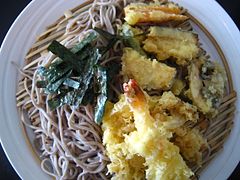Tempura


Tempura , also Tenpura , ( Japanese て ん ぷ ら / 天 ぷ ら / 天 プ ラ / 天 麩 羅 / 天婦羅 ) is a variant of the preparation of fried food in Japanese cuisine . With a batter made of flour, egg and ice water, various types of fish, mushrooms and vegetables as well as sprouts and young leaves are quickly baked in hot (140 to 190 ° C) oil.
preparation
In Japan, fine tempura flour is used for the batter , which is made from rice and which is sometimes available in Asian grocery stores or in delicatessen stores in other countries. Wheat flour can also be used instead of tempura flour. Prawns and lobster crabs are particularly suitable for frying . The preferred vegetables include sweet potatoes, lotus, eggplant, pods, onions, carrots, peppers, zucchini, asparagus tips. Outside of Japan, meat (especially turkey) and fruit (e.g. banana) are also prepared this way.
Tempura was originally left over from the fat or frying pan, in which small pieces of dough and vegetables were skimmed off after the main fried food and offered as a particularly crispy, salty version.
In contrast to the other customs of Japanese cuisine, tempura is very fatty. It is consumed as a main course and also as a combined dish with soba , on rice (as " tendon ") and other low-fat dishes. Tempura is usually eaten with Tentsuyu sauce or with a dip sauce made from rice wine and soy sauce to which grated radish and ginger are added, immediately after preparation. Tempura has also found its way into sushi and is often used as a warm filling. Outside of Japan, whole sushi rolls are also prepared as tempura.
In Italy there is a very similar method of preparation called fritto misto .
history
The preparation and the word tempura were probably in the 16th century by Portuguese Jesuit - missionaries adopted. The word tempura is derived from the Latin tempora (times), which is an allusion to Lent, when the Catholic Church did not allow Christians to be meat.
Picture gallery
Tempura with soba noodles (here, among other things, with fried prawns and various vegetables)
Tendon (dish made from tempura on rice; here with fried fish)
Tempura menu with rice, miso soup (in the covered bowls), Tentsuyu sauce and fried vegetables
literature
- WDR : ARD-Ratgeber Eating & Drinking / 1992, October. Baking in the oven and deep fryer: tempura and apple strudel. Walter Rau Verlag, Düsseldorf 1992, ISBN 3-7919-0466-3 .
- Chris Rowthorn et al. a .: Japan (= Lonely planet ). Translation from English by Julie Bacher a. a., chief. of the German edition: Birgit Borowski. 2nd German edition. MairDumont, Ostfildern 2010, ISBN 978-3-8297-1657-4 , pp. 87-88 ( limited preview in the Google book search)
Web links
Individual evidence
- ^ David Farley: The truth about Japanese tempura. Retrieved August 12, 2017 .


